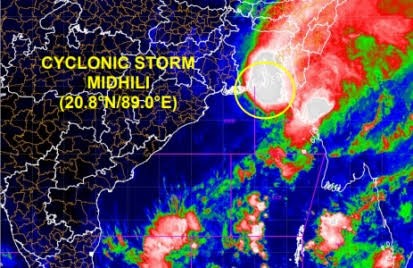
Cyclone Midhili

22.11.2023
Cyclone Midhili , Daily Current Affairs , RACE IAS : Best IAS Coaching in Lucknow
|
For Prelims: Cyclone Midhili,Cyclones For Mains paper:Favourable Conditions for Formation of Cyclones,Types of cyclones,Naming of cyclone |
Why in the news?
Cyclone Midhili, moving north-northeastwards over the Bay of Bengal, is expected to intensify with winds up to 85 kmph and make landfall near the Khepupara coast of Bangladesh.
About Cyclone Midhili
- The name ‘Midhili’ for the cyclonic storm was given by the Maldives.
- Cyclone Midhili was moving north-northeastwards at 25 km/h over the northwest and adjoining northeast Bay of Bengal.
- The cyclone was centered about 30 km south-southwest of Khepupara, Bangladesh, and 250 km southwest of Chittagong, Bangladesh.
- It is forecasted to make landfall near Khepupara on the Bangladesh coast, with squally winds expected during the process.
- It is accompanied by an upper air cyclonic circulation over the southwest Bay of Bengal and adjoining Sri Lanka, and another cyclonic wind area in the south Andaman Sea.
- Heavy to very heavy rain was expected in parts of Nagaland, Manipur, Mizoram, and Tripura.
- Warnings have been issued of potential damage in coastal areas of West Bengal, particularly North 24 Parganas.
What are Cyclones?
- Cyclones are large-scale air masses that rotate around a strong center of low atmospheric pressure.
- They are characterized by inward spiraling winds that rotate counterclockwise in the Northern Hemisphere and clockwise in the Southern Hemisphere.
Favourable Conditions for Formation of Cyclones
Warm Ocean Water: Sea surface temperatures must be around 26°C or higher. This warmth provides the necessary energy for the cyclone to form.
Atmospheric Instability: Warm, moist air rising from the ocean surface leads to the formation of cumulus clouds, which can grow into a cyclone under the right conditions.
Moisture in the Atmosphere: High humidity, especially in the lower and middle levels of the troposphere, aids in the development of clouds and thunderstorms within the cyclone.
Low Wind Shear: Low levels of wind shear (changes in wind speed and direction with height) are essential. High wind shear can disrupt the cyclone's structure.
A Pre-existing Weather Disturbance: A cyclone often forms from a pre-existing disturbance in the atmosphere, like a tropical wave, which provides an initial structure for storm development.
Coriolis Effect: This is necessary to create the spin in the cyclone. It becomes effective at least 5° away from the equator.
Distance from the Equator: Cyclones typically form at least 5° away from the Equator since the Coriolis effect is too weak near the Equator to create the cyclonic rotation.
There are two types of cyclones:
-
- tropical cyclone and
- Extratropical cyclones (also called temperate cyclones)
1.Tropical Cyclone:
- It is an intense circular storm that originates in warm tropical oceans.
- It is characterized by low atmospheric pressure, strong winds and heavy rainfall.
- These are formed over slightly warm sea water.
- For a cyclone to form, the temperature of the upper layer of the ocean, to a depth of about 60 metres, must be at least 28°C.
- The periods April–May and October–December are favorable for cyclones.
- Then, low levels of air over the water require a 'counter-clockwise' rotation (in the Northern Hemisphere; clockwise in the Southern Hemisphere).
- During these periods, there was an ITCZ in the Bay of Bengal.
2.Extratropical cyclone:
- It occurs in temperate regions and high latitude regions, although it has been known to originate in polar regions.
- They are active over the mid-latitude region between 35° and 65° latitude in both hemispheres.
- The direction of movement is from west to east and is more pronounced during the winter season.
Naming of cyclone:
- Tropical cyclones that form over different ocean basins are named by centers that are associated with the area of the cyclone in question such as Regional Specialized Meteorological Centers (RSMC) and Tropical Cyclone Warning Centers (TCWC).
- There are six regional centers across the world, including the India Meteorological Department's RMSC, and six TCWCs responsible for naming cyclones as well as issuing advisories.
- In tropical regions, a cyclone is named when it is determined to have attained cyclonic storm intensity, with wind speeds of 65 kilometers per hour (40 mph).
- These names have been selected from the new roster provided by the Regional Specialized Meteorological Center in New Delhi around mid-2020.
- If the tropical cyclone enters the basin from the western Pacific, it will keep its initial name.
The names of cyclones are proposed in alphabetical order and are used in that order.
- The names of the countries which are affected by the cyclones formed in the Arabian Sea and the Bay of Bengal are as follows - 1) Bangladesh, (2) India, (3) Iran, (4) Maldives, (5) Myanmar. , (6) Oman, (7) Pakistan, (8) Qatar, (9) Saudi Arabia, (10) Sri Lanka, (11) Thailand, (12) United Arab Emirates, (13) Yemen.
The names are chosen in a way that assures neutrality in its political and religious nature. Naming storms is a lengthy process and involves neutral officials. It is ensured that the names do not hurt the sentiments of any community.